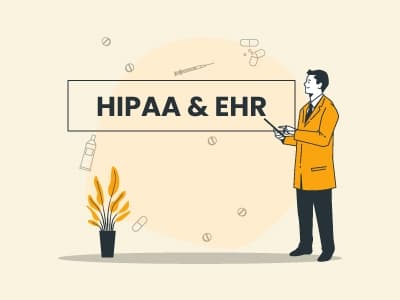
Electronic health records, or EHRs, have become a cornerstone of modern healthcare delivery by facilitating a more coordinated and patient-centered approach to care. However, these systems store highly sensitive health information, which is vulnerable to security risks like unauthorized access, data breaches, and theft.
To protect this data, healthcare providers are required to comply with strict regulations set by the Health Insurance Portability and Accountability Act (HIPAA). Non-compliance can not only cause reputational damage but also lead to multi-million-dollar fines.
In this guide, we will help you understand the key HIPAA requirements for an EHR and highlight best practices to ensure compliance with these standards.
HIPAA is a federal law that sets the standard for protecting sensitive patient information when it comes to EHR systems. The HIPAA requirements and regulations for EHR fall under the Security Rule, which outlines specific safeguards healthcare providers must implement to protect electronic protected health information (ePHI).
What Is Electronic Protected Health Information?

Electronic protected health information (ePHI) is any health information stored, received, or transmitted in an electronic format. Healthcare organizations are responsible for protecting the integrity and confidentiality of ePHI maintained within their EHR.
Common HIPAA Violations
HIPAA violations can occur when issues are identified through patient complaints or data breaches, which may result in financial penalties.
The ongoing nature of cybersecurity threats and EMR HIPAA violations is equally challenging for both small and large healthcare practices.
As Ross A. Leo, a cybersecurity expert at ObservSMART, notes in a recent webinar with Software Finder:
"The healthcare industry, as a whole, is a major target for hackers around the world. It is a threat to businesses of every size. Whether you are a small practice or a large urban hospital, you are at risk. So, it is crucial to be proactive in protecting patient data and ensuring HIPAA compliance."
The Main Types Of HIPAA Safeguards

Security regulations regarding EMR/EHR, according to HIPAA, require healthcare providers to implement three types of safeguards to secure protected health information (PHI).
According to the HIPAA Journal, 5,887 healthcare data breaches involving 500 or more records were reported to the office for civil rights (OCR) between 2009 and 2023, which resulted in the exposure of 519,935,970 healthcare records.
The following safeguards are designed to protect organizations from such data breaches and ensure HIPAA and EHR compliance.

For more information about HIPAA safeguards and EHR privacy and security questions, refer to our comprehensive piece on EHR security questions to ask vendors before implementation.

Most HIPAA-compliant EMR systems come with built-in security features to protect sensitive information. However, they are not always properly configured, which can expose patient data to security risks.
To address this, the HIPAA electronic medical records requirements outline various practical measures to protect ePHI. Here are a few security measures that can be employed to meet EHR and HIPAA requirements:
Access Control
Access control systems within EHR software provide both physical and cybersecurity measures to enhance data protection. These tools allow data owners to determine who can access, edit, or share information.
According to the department of health and human services (HHS), access control tools like passwords and PIN numbers help limit access to sensitive health information, ensuring that only authorized individuals can view or modify patient records.
Wes Gyure, executive director of product management for identity and access management at IBM Security, highlights the importance of this EHR security measure, saying,
"Access control is paramount for securing sensitive and protected resources. Failure to properly manage access can have a huge impact on costs, brand damage, or even operational downtime."
A study published in Informatics in Medicine Unlocked further emphasizes that access control creates a security barrier to protect data within healthcare systems.
Three Types Of Access Control Systems
The three main types of access control systems for effective HIPAA and EHR implementation include:
Encryption
Encryption is a vital security feature that ensures data is unreadable to anyone without the correct decryption keys. In the context of EHRs, encryption helps protect PHI by converting it into a coded format. Even if unauthorized personnel gain access to encrypted data, it remains useless without the necessary cryptographic keys.
A study published in the National Library of Medicine highlights that technical safeguards like encryption can prevent electronic breaches even when unauthorized personnel bypass the physical safeguards.
Under the HIPAA Security Rule, encryption is strongly recommended as a best practice. The rule's primary goal is to ensure that ePHI is unreadable and unusable to those who do not have permission to view it. Other related standards, such as password management and emergency mode operation plans, should also be considered when implementing encryption.
Audit Trail
An audit trail is a chronological, detailed log of system activities, including data access, queries, and modifications. In healthcare, these records serve a critical function in improving security, maintaining compliance, and preparing for audits. They provide a clear view of who accessed patient data, when, and what changes were made.
HIPAA Audit Trail Requirements
Audit logs are essential for HIPAA compliance electronic health records, as they allow practices to monitor who has access to their data. By establishing an audit trail, healthcare providers can quickly detect breaches and ensure compliance with the HIPAA’s minimum necessary standard.

Protecting patient data is an ongoing responsibility that requires constant vigilance. As your practice continues to adopt and rely on EHR systems, staying HIPAA compliant isn’t a one-time task but a continuous process. A thorough security risk analysis and regular mitigation measures must be part of your practice’s day-to-day operations to ensure that PHI remains secure.
Jim Trainor, Senior Vice President of Aon Cyber Solutions, emphasizes that
“the level of security across the industry is not where it needs to be to protect patients’ healthcare information.”
This highlights the need for healthcare facilities to remain proactive in their approach to data protection.
For further guidance on effectively meeting EHR and HIPAA compliance requirements for your healthcare clinic, refer to our regulatory compliance checklist.

